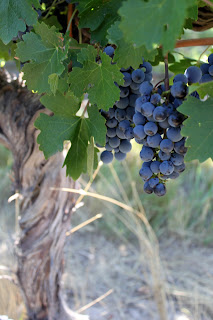After a couple of
surprisingly unsophisticated days in downtown Mendoza and the roads of Maipu, we
booked some activities to try to salvage this trip.
Along with our new
Australian friend, Anna, we hired a driver to take us to another one of the wine
growing areas of Mendoza called Lujan de Cuyo. Most of the hired chauffeurs
around town drive classy sedans. Instead, the three of us toured around the
bodegas in a mini bus.
Almost immediately
when we arrived in the Lujan area, we knew we were in for a good day. This is
the landscape we had been looking forward to!
Our first stop was Tapiz, a label that we had bought many
times in San Diego. Compared to the boutique wineries from Maipu, Tapiz
produces 2.2 million bottles a year. The three of us had a private tour with
our guide, Juan. First thing first, Juan ushered us out of the bodega to an
awaiting horse-drawn carriage. The two horses, Cabernet and Malbec, trotted us
out into the vines with the Andes Mountains as the backdrop. Redeeming moment
#1.
Juan is extremely
passionate about wine and taught us all sorts of things like how to
taste a grape, how to tell if the grape is ready for harvesting based on the seed color, and how to differentiate between grape varietals by looking at the leaves. I had never
really noticed the difference before, but the Cabernet leaf is on the left, and
the Malbec leaf is on the right.
After our little
workshop in the vines, we got back in our carriage and rode off towards the
main house. Along the way, we passed by the workers hand-picking the grapes.
Each time they fill a bin, they get a token, which they redeem for money at the
end of the day.
Once we got back to
the processing facility, we compared the differences between unfinished fermenting
wine in the tanks to that in the processed bottles.
We learned that Tapiz
also produces the Zolo label, which was another one of our favorites in San
Diego. Apparently the Tapiz family is good friends with the Bevmo family, so if
you’re from California, you know what I’m talking about!
Our next bodega stop
was Achaval-Ferrer, where we had
another charming guide who had “followed the wine from France” and landed in
Mendoza. He showed the three of us around their facility where they use
concrete tanks instead of stainless steel. Then we went out onto their lawn,
which overlooks the Andes, and tasted several of their wines. Redeeming moment
#2.
We had a nice picnic
lunch at Achaval-Ferrer before continuing onto to meet the best character all
day, Carmelo Patti. Carmelo and his
daughter personally showed the three of us around his makeshift winery that is
so small it doesn’t even have a sign along the road. Carmelo had come highly
recommended by my friend Brian Gillespie, and he did not disappoint. He doesn’t
speak any English, but he also didn’t let our language difference get in the way
of communicating. He’s a scientist of sorts who liked to show us his
hand-written, wine-splattered diagrams depicting at what age his wines will be
at their peak of perfection. Redeeming moment #3. Unlike other wineries, Carmelo
hordes most of his wine, letting it age many years before he releases it.
Our last stop of the
day was Luigi Bosca. They produce a
whopping (for Mendoza) 8 million bottles a year. It was a nice place, but it
also reminded me of former winery visits in America. Even though we only had 5
people total on our tour, it still felt kind of sterile. It gave me perspective
on how incredibly lucky we were to receive such personal attention at Carinae,
Domaine St. Diego, Tapiz, Achaval-Ferrer and Carmelo Patti. Thank goodness for
these wineries as they restored our faith in Mendoza.










No comments:
Post a Comment